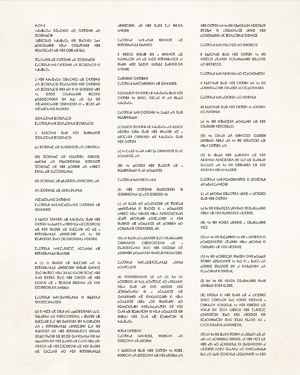National Consensus of Talahara
This article is incomplete because it is pending further input from participants, or it is a work-in-progress by one author. Please comment on this article's talk page to share your input, comments and questions. Note: To contribute to this article, you may need to seek help from the author(s) of this page. |
| Constitution of Talahara ⵇⴰⵏⵓⵏⵀⵍⵓ Qanunhlu | |
|---|---|
 | |
| Jurisdiction | Talahara |
| Created | May 9, 1841 |
| Date effective | June 20, 1841 |
| System | Directorial council republic |
| Branches | 3 |
| Chambers | |
| Executive | |
| Judiciary | |
| First legislature | June 30, 1841 |
| Amendments | 5 |
| Last amended | February 14, 2008 |
| Commissioned by | Commune Council |
The Constitution of Talahara (Takelat: ⵇⴰⵏⵓⵏⵀⵍⵓ; Qanunhlu) is the supreme law of the Communes of Talahara. Drafted over a period of three years between 1838 and 1841, the first two parts of the constitution enshrined the rights and freedoms of all persons in Talahara, in addition to democratic and property rights. Part three of the constitution was completed later in 1841 and codified the roles of the three branches of government and divisions of power between national, regional, and communal levels of government.
Both laws created by the Legislative Councils of Talahara and the executive functions of government must abide by the protections and limitations enshrined by the constitution. Constitutional principles are also used alongside Talaharan customary legal principles to interpret laws.
The constitution has been amended a total of five times. These amendments include the addition of the third part, electoral reform, and the addition of new rights and protections. Constitutional amendments require the passage of a provision by a two-thirds supermajority in the Supreme Legislative Council (34 of 50 members) and subsequent ratification by a two-thirds supermajority by the membership of the 1,250 Communal Legislative Councils in Talahara (8,334 of 12,500 members).
History of the Constitution
The drafting of the Constitution of Talahara represented the culmination of Talahara's legal history. The drafting committee drew inspiration from numerous sources, including traditional Talaharan laws and traditions, liberal constitutions, and socialist philosophy. The actual process of drafting the document was contentious, with major debates over the question of which influences were legitimate and functional for the new Communard society and to what degree of importance each source ought to have.
Sources and values
Prior to the Talaharan Civil War, Talaharan law was derived from two main sources. The first source was the customary law of the Kel Aman and Kel Hadar clans. These customs informed and regulated social conduct and property relationships. The second source of law was the notion of natural law, which was promoted by the monarchs, including the Assembly of Chiefs. Talaharan interpretations of natural law described law and society as expressions of the natural order, distinct from the cultural importance of customary laws.
Natural law encompassed royal edicts, laws that were effectively created or rescinded by a monarch. These proclamations were described as "discoveries" or "corrections", respectively. Modern sociologists have likened the distinctions between customary and natural law in Talahara as reflecting proto-symbolic interactionist and structural functionalist perspectives on the law.
Liberalism
Socialism